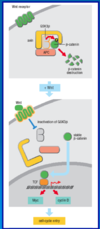Unit 4 - General Concepts of Cancer and Protecting the Genome Flashcards
(73 cards)
cancer - biology vs molecular level
out of control cellular proliferation (bio)
damage to genetic material (mutations and epigenetic) that affect cellular proliferation
3 types of mutations in cancer cells
ONCOGENIC
TUMOUR SUPPRESSIVE
NEUTRAL
oncogenic mutation
ras
myc
cyclin D
normal growth promoting genes (proto-oncogenes) become either hyperactive or inappropriately active
dominant mutations = mutation of only 1 allele required
tumour suppressive mutation
normal growth restraining genes become lost or down-regulated
recessive mutation = mutation of both alleles required (to lose tumour suppressive function)
BRCA1 and 2
TP523
neutral mutation
cancer cells have 1000s of mutations to genes that have little or no effect on aetiology of cancer
cancer evolves a mutagenic phenotype
protooncogenes when mutated =
driving with foot on the accelerator
normal (stem) cells
low instability
no cells have genetic alteration required to overcome the selection barrier
NO TUMOUR
increased genetic instability
at least 1 cell contains the requisite genetic alteration to overcome the selection barrier (clonal selection)
barrier traversed and population of mutant cells eventually accumulates the new mutations required to cross the next selection barrier
significant step towards tumourigenesis

too much genetic instability
too many mutations accumulate to allow viability
cells die - apoptosis, necrosis
NO TUMOUR
6 selection barriers
reduced requirement for growth factors - autocrine stimulation
insensitivity to inhibitory signals
escape from senescence (cellular immortality)
evasion of apoptosis
stimulated angiogenesis
invasion/metastases
how are these selection barriers overcome
by inactivating tumour suppressors and activating oncogenes
tumours - hostile cellular environments
e.g. periods of anoxia, malnutrition
fluctuating hormonal influences and immune attack
a fertile breeding ground for mutations
similarly, bacteria with higher levels of genomic instability, but not too high, adapt to and eventually dominate new environments
challenge posed by the somatic mutation hypothesis
very low mutation rate - 1 x 10-10 nucleotides/cell/division for human somatic cells
diploid human genome = 6.4 x 109
1016 cell divisions in a human lifetime are insufficient to permit a single cell to obtain the estimated 5-7 advantageous mutations required to produce a cancer
⇒ cancer shouldn’t occur with such a low mutation rate
the mutator (or genetic instability) hypothesis
cancer cells have significantly elevated (just-right) mutation rates
Min tumours
where is there instability
type of karyotype
prevalence
microsatellite instability
instability at the nucleotide level e.g. mutation of MMR results in 10-100 fold increase in mutation
most easily seen at microsatellites
normal karyotype
relatively uncommon e.g. 15% colorectal cancers
Cin tumours
where is there instability
karyotype
prevalence
chromosomal instability
instability at chromosomal level
not clear what mutational events initiate Cin tumours - loss of p53, mitotic checkpoints?
abnormal karyotype
most frequent - 85% of colorectal cancers
similarity between min and cin
NOT FOUND TOGETHER
same oncogenes and tumour suppressors appear to be targeted in both min and cin tumours
what is the lifetime risk of many cancers dependent on
the total number of divisions of adult stem cells in the particular tissue rather than on environmental or inherited mutations
the more cell divisions the more likely that random mutation to key cancer driver genes will occur during cell division - 65% of cancer
what explains the extreme variation in cancer incidence across different tissues
> cell divisions ⇒ the more likely that random mutation to key cancer driver genes will occur during cell division
cancer risk for different tissues
- 9% - lung
- 08% - thyroid
- 6% - brain
- 003% - pelvic bone
- 00072% - laryngeal cartilage
proportion of cancers that have an inherited component
5-10% of cancers
what effect does exposure to mutagens have
mutagens or viruses cannot account for a 24x variation of lifetime risk throughout alimentary canal
LI - 4.82%
stomach - 8.6%
oesophagus - 0.51%
SI - 0.2% - 3x LESS COMMON than brain tumours even though the brain is protected from environmental mutagens by the BBB
lifetime risk vs total stem cell divisions

tumour
an abnormal uncontrolled growth without physiological function, that can be either benign or malignant
benign tumour
confined and not life threatening
















